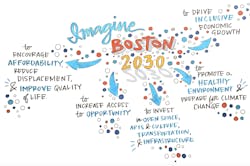As the manufacturing industry works toward the design and deployment of more flexible and efficient production facilities, it is becoming increasingly clear that efforts can be buoyed by a bigger ecosystem that includes the environment, infrastructure, and people. Whether it’s addressing climate change and carbon emissions, building a seamless supply chain, or cultivating an inclusive workforce, it is the collective efforts of business, academia, and government that can transform the way we live, work, and play.
I had that in mind when I was recently invited to a salon-style dinner in Boston’s Seaport District, sponsored by Dell Technologies. The group included Dell executives, Boston city officials, industry analysts, and journalists. And the open discussion focused on a few key themes, one of which being how Boston can transform into a smart city as defined within the Imagine Boston 2030 initiative.
Imagine Boston 2030, initiated under the direction of Boston Mayor Marty Walsh, is addressing the innovation of 10 different areas: arts and culture; economy; education; energy and environment; health and safety; housing; land use and planning; open space; technology; and transportation.
Because it is all about the people of Boston, the first step was to go out and gather feedback from residents about what they wanted. Between 2015 and 2017, over 15,000 Boston residents were interviewed and their thoughts were captured and distilled into new objectives and guidelines.
“We went out and asked them what their fears and concerns were for the future, as well as what they were excited about,” said Natalia Urtubey, executive director of Imagine Boston. By understanding their hopes and needs, the team was able to narrow the goals. “The overarching premise is to improve the quality of life,” she said.
To that end, two larger themes of Imagine Boston are an empowered and inclusive workforce and the use of technology as a great equalizer. The Imagine Boston team is exploring the role of technology as it digitizes information to make data more useful, which can be as simple as a parking app or as sophisticated as mobile healthcare that brings the doctor’s office to the neighborhood where it is needed the most. Robots and artificial intelligence will have a major role as well. And, of course, there are metrics required to measure success.
“Digital transformation is business-centric, the smart city is residential-centric,” noted David Elges, CIO for the City of Boston. “There’s a lot to tackle in this target-rich environment, so it will take public and private partnerships.”
Indeed, everything is interconnected in some way, shape, or form.
The Imagine Boston 2030 plan is written and now it’s time to execute on the ideas. This requires a framework for the vision, and for that, Urtubey said, the city will need the help of businesses. “The private sector has influence on consumers. Pick that thing that [your company] is passionate about and figure out how to achieve that,” she said. “If it’s a better quality of life for workers, then how does every business play a role in achieving that?”
The dinner conversation was casual and meant to stimulate questions and welcome different perspectives. And, much of the discussion centered around the same pain points we feel in the manufacturing industry, such as the correct use of technology to achieve each goal and the skills shortage—or rather, engaging workers with new jobs that are empowering.
That discussion resulted in one of the most interesting comments of the night from John Roese, chief global technology officer at Dell, who referenced a study that revealed businesses hiring engineers are looking for one specific characteristic: Compassion. “They want critical thinkers with empathetic skills,” Roese said.
Engineers instinctively are problem-solvers, but tomorrow’s workforce must also be good listeners and be able to communicate and understand others in order to effectively collaborate. I don’t think they teach empathy as part of the engineering curriculum, but it’s a good lesson for every individual and every modernization effort—be it for the City of Boston or for your manufacturing operation.
Leaders relevant to this article:

